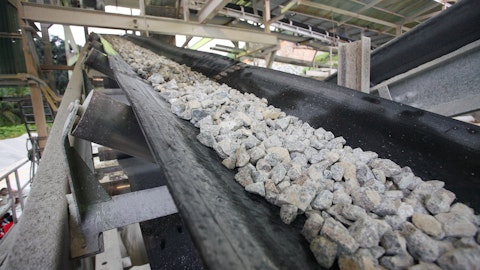But here’s what you and I know, the pricing is going to stick and the volume is going to come back. And when those two things happen, what you have is a margin expansion show, that’s really quite impressive. So if we look at the overall difficulties of doing our business, the overall difficulties of getting into our business, and the degree of work that we have to go through to put a quality specification product on the ground safely, I think talking to our teams about value is an important conversation for us to have. And from a customer perspective, what we’ve largely seen is if they have enough time to work those numbers into their bid, it tends to work relatively well from their perspective as well. So, look, as we’ve said before, I think if we’re in a world that we’re looking at pricing the way it was looked at in our company here four or five years ago, going forward, something has gone wrong at that point.
I just — I believe, we’re in a different period of time, a different economic cycle, and a different way of thinking about value of our product in the ground and in the stockpile.
Adam Thalhimer: Good color. Thanks, Howard.
Howard Nye: Thank you, Adam.
Operator: And your next question comes from the line of David MacGregor from Longbow Research. Your line is open.
David MacGregor: Yes. Good morning, everyone. Thanks for taking my questions. Howard, congratulations on all the progress on the portfolio management. Very impressive.
Howard Nye: David. Thank you. Thank you so much. You’ve watched it a long time, so you’ve been able to see it.
David McGregor: Yes. Well, it’s still going. It sounds like it still has more to go. I wanted to just ask you about the weather impact in the first quarter and how that may have complicated price realizations on your — beginning of your pricing. I know you kind of touched this in response to a previous question, but I may want to come at this slightly different angle. Can you just talk about the variance that you’re seeing on kind of an MSA to an MSA basis across your footprint in terms of traction on this price increase? And also from a weather standpoint, given that maybe some of this is getting pushed out a little bit, does it leave you may be looking at some ASP pressure temporarily in 2Q before you’re able to get a greater footing on those price actions in 3Q and beyond?
Howard Nye: David, thank you for the question. I would say several things. No, to the last part of your question. First, I don’t think it puts any degree of 2Q pressure on that. And again, we think we’re going to see degrees of mid-years even beyond what we already built into the guide right now. What I would say relative to the weather, it was really more of a Southwest issue than anything else, because there was so much rain in Texas and it was so considerably different year-over-year. We did see degrees of deferrals in some places in Texas from January 1 to April 1, and that was part of the conversation that I was having a bit earlier relative to cement in particular. So I do think the weather in that unique circumstance played a bit of a role.
But again, keep in mind, a lot of the country was accustomed to seeing April 1 pricing. So this notion of pushing everything to January 1 was really something that we’ve introduced with our customer base here over the last, let’s call it 18 months to 24 months anyway. So I think if I’m looking at whether, how it affected pricing, I think that was it. I think it was relatively discreet. I don’t think it puts any degree of undue pressure on what we’ll see here in the second quarter or for the balance of the year. And I do think it’s one of the reasons, again, that we’re going to be at least looking at the prospect of some September price increases in cement because it was a little bit slower coming out of the gate in January. David, does that help?
David McGregor: Yes, it does. Thanks very much, Howard.
Howard Nye: You bet. Good to talk to you.
Operator: And your next question comes from the line of Timna Tanners from Wolfe Research. Your line is open.
Timna Tanners: Yes. Hey, good morning.
Howard Nye: Hi, Timna.
Timna Tanners: I wanted to ask about the data center commentary with regard to the 800,000 tons. Is that normal for a data center? Is that — that particular Google one you mentioned? And also, how do we compare that with the footprint of the warehouse? I’ve heard some comparisons there, just wondering like size-wise, how they compare against one another. And I think there was an earlier question about maybe your caution there, but it is in your presentation as something you’re more cautious on. So I just want to make sure we understand that?
Howard Nye: Yes, good question, Timna. Look, I don’t look at that and think of that as being anywhere outside of a normal fairway on what you’d expect on that type of a large commercial project in that type of space. So do I think that’s pretty consistent with degrees of other large warehousing? Yes, I think it probably is. Because if you think about it, Timna, several things are happening. One, they’re doing the normal site work, that’s going to take a good deal of base. At some point, they’re putting up — putting in the floors that will typically be concrete. At some point, too, they’re going to build the walls and keep in mind, this isn’t typically an exercise in aesthetics. In other words, it’s not going to be brick. It’s not going to be other things that are painted for beauty in large measure, although I’m not saying there’s not beauty in concrete walls, in large measure these will be concrete tilt up walls.
And then the last piece of it, it goes back to some of the conversations I had earlier. Often times you’ll see TPO roofing on these. And I referenced relative to the question on a read-through in Mag, was there anything that could pull through? I think this is an example of that. So, no, 800,000 tons isn’t unusual. Two, I think it’s about in the middle of the fairway. Three, that what the typical build looks like at one of these. And as you know, for us, in many respects, it’s all about location and what I was referencing there in particular, we’re the largest underground miner in aggregates in the United States. And when we get in the central part of the United States in particular, we’re able to use our underground mine locations to actually be closer to market centers than we would be able to if we were mining in open pit locations.
And what that means is, this facility that we’re talking about is one that is literally almost above us. So from a proximity perspective, Timna, it actually works very well.
Timna Tanners: That’s helpful. Color. I like the beauty and concrete. Thanks again.
Howard Nye: Well, I appreciate that, Timna.
Operator: All right, thank you. And that concludes our Q&A portion for today’s call. I would like to turn it back to Howard Nye for closing remarks.
Howard Nye: Thank you all for joining today’s earnings conference call. In summary, we believe our commitment to world-class safety, commercial and operational excellence in sustainable business practices position us to provide compelling results for the foreseeable future. Thanks to our best-in-class teams, differentiated business model, well-defined strategic plan, and unrivaled growth opportunities, Martin Marietta is well-positioned to continue driving sustainable growth and superior shareholder value as we build and maintain the world’s safest, best-performing, and most durable aggregates-led public company. We look forward to sharing our second quarter, 2024 results in the summer. As always, we’re available for any follow-up questions. Thank you again for your time and continued support of Martin Marietta.
Operator: Thank you presenters. And ladies and gentlemen, this concludes today’s conference call. Thank you for participating. You may now disconnect.
Follow Martin Marietta Materials Inc (NYSE:MLM)
Follow Martin Marietta Materials Inc (NYSE:MLM)
Receive real-time insider trading and news alerts




